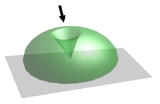
Keyhole problem
Encyclopedia
The keyhole problem in the context of astronomy
refers to the difficulty that azimuth-elevation
type telescopes or antenna gimbal
systems encounter in crossing the zenith
.
 To track celestial objects as they move across the sky, these systems usually rotate on two axes. Often a tilting mechanism (elevation) is mounted upon a panning base (azimuth). In order to cover the complete hemisphere of visible sky, a telescope gimbal could have a 360 degree azimuth range and 0 to 90 degree elevation range. In order to visualize this shape, imagine drawing a quarter circle spanning from the horizon to directly above you and revolving it around the vertical axis.
To track celestial objects as they move across the sky, these systems usually rotate on two axes. Often a tilting mechanism (elevation) is mounted upon a panning base (azimuth). In order to cover the complete hemisphere of visible sky, a telescope gimbal could have a 360 degree azimuth range and 0 to 90 degree elevation range. In order to visualize this shape, imagine drawing a quarter circle spanning from the horizon to directly above you and revolving it around the vertical axis.
If, on the other hand, the gimbal has a range from 0 to slightly less than 90 degrees elevation, there will be a region of sky that is not viewable by the telescope (see figure).
Astronomy
Astronomy is a natural science that deals with the study of celestial objects and phenomena that originate outside the atmosphere of Earth...
refers to the difficulty that azimuth-elevation
Horizontal coordinate system
The horizontal coordinate system is a celestial coordinate system that uses the observer's local horizon as the fundamental plane. This coordinate system divides the sky into the upper hemisphere where objects are visible, and the lower hemisphere where objects cannot be seen since the earth is in...
type telescopes or antenna gimbal
Gimbal
A gimbal is a pivoted support that allows the rotation of an object about a single axis. A set of two gimbals, one mounted on the other with pivot axes orthogonal, may be used to allow an object mounted on the innermost gimbal to remain immobile regardless of the motion of its support...
systems encounter in crossing the zenith
Zenith
The zenith is an imaginary point directly "above" a particular location, on the imaginary celestial sphere. "Above" means in the vertical direction opposite to the apparent gravitational force at that location. The opposite direction, i.e...
.
Area of Visible Sky

If, on the other hand, the gimbal has a range from 0 to slightly less than 90 degrees elevation, there will be a region of sky that is not viewable by the telescope (see figure).

